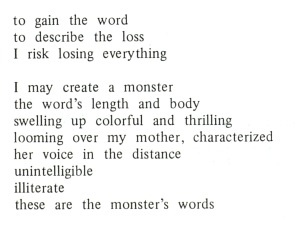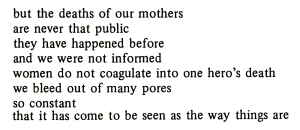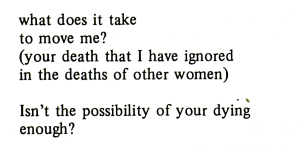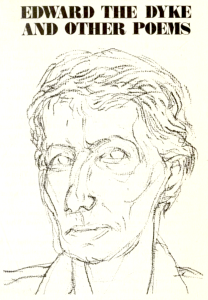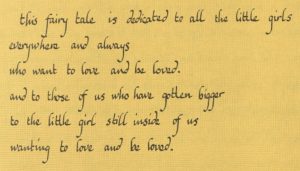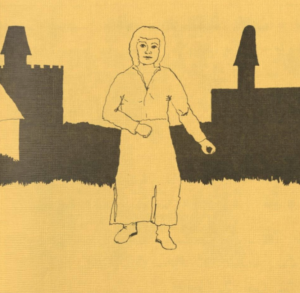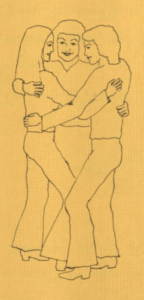The fall 1979 and the spring 1980 issues of the feminist periodical Sinister Wisdom contain an interview with Joan Nestle and Deborah Edel, two of the founders of the Lesbian Herstory Archives.
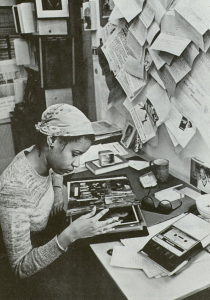
Photograph of archivist working in the Lesbian Herstory Archives, taken by JEB, and published in the fall 1979 issue of Sinister Wisdom
Nestle and Edel detail the process of creating the Archives and how a community was formed in that process. The Archives became a dormitory, a dining area, a research space, and the center of the lesbian community. The interviewer, Beth Hodges, remembers the night of the 1974 Gay Academic Union, when the Archives had “women sleeping all over the floor,” and Nestle and Edel were “so happy to have a lesbian house party” (Hodges 12). The Archives became more than just a collection of books, poems and art. It became a safe space for women to breathe freely and create community, which had not been possible for lesbians before this time. Nestle, Edel and the other founders of the archive intended for the Archives to be “an on-going intergenerational place that would be for all lesbian women” (Hodges 9).
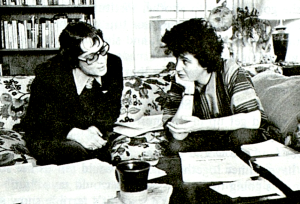
A photograph of two archivists looking over material in the Lesbian Herstory Archives, taken by JEB, and published in the fall 1979 issue of Sinister Wisdom
The Lesbian Herstory Archives are still active today. Their collection has grown and they have moved into digital space as well. The Archives now have internships and have created the Lesbian Studies Institute, which offers courses about lesbian lives and identities. Like Joan Nestle and Deborah Edel hoped, the archives have expanded, but the mission never changed. The Archives still value all lesbian lives and take care to preserve the diversity of lesbian history. “There’s a huge rich tradition of cultural groups, organizations, sisterhoods, where Black lesbian women spent much of their time and from which they got great strength” which the Archives recognizes and tries to memorialize within their collection (Hodges 103). The Archives has always worked hard to include disabled women, so that if a woman “cannot use a typewriter or cannot use a tape, we have to find ways for her to record her life” (Hodges 103). Nestle and Edle knew they must consciously and thoughtful preserve lesbian history so that they don’t “duplicate the invisibility of the other society” (Hodges 103). The Archives continues this goal into present day so that the history of all lesbian women, regardless of race, class, ability or culture is remembered.
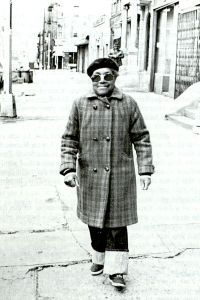
A photograph of Mable, one of the early contributors to the Lesbian Herstory Archives, taken by JEB, and published in the fall 1979 issue of Sinister Wisdom
The Archives foster intergenerational connection through this preservation of lesbian history. Nestle and Edle explained that older women have “incredible stories they have to tell and struggles they have had to go through” and that these stories are important to preserve and pass down to the next generation (Hodges 103). Nestle wanted “the Archives to give us back our generational connections to deepen our understanding of how we survived and the courage of each generation” (Hodges 103). This intergenerational connection creates power and sustains the lesbian feminist movement. Nestle described how the roots of the word archive mean “beginning” and “power.” This is how the Archives are seen: “It means power of control over our beginnings and our continuing” (Hodges 105). Knowing that there has been and continues to be spaces like the Archives where lesbian women can come together motivates the next generation and gives them the power and knowledge to continue fighting for their freedom.
Works Cited:
Hodges, Beth. “An Interview with Joan and Deborah of the Lesbian Herstory Archives.” Sinister Wisdom, no. 11, Oct. 1979, pp. 3-13, https://jstor.org/stable/10.2307/community.28044739.
Hodges, Beth. “Preserving Our Words and Pictures.” Sinister Wisdom, no. 13, Apr. 1980, pp. 101–105, https://jstor.org/stable/community.28044741.

